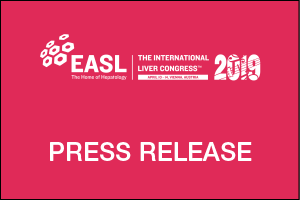
ILC 2019: Study involving >29,000 individuals with chronic hepatitis B virus infection reports that the risk of hepatocellular carcinoma is at least one-third lower in those treated with tenofovir than in those treated with entecavir
13 April 2019, Vienna, Austria
EASL (EUROPEAN ASSOCIATION FOR THE STUDY OF THE LIVER)
A large observational study involving more than 29,000 adults with chronic hepatitis B virus (HBV) infection has reported that the antiviral, tenofovir (TDF), is associated with at least a one-third lower risk of hepatocellular carcinoma (HCC) than entecavir (ETV). The study reported today at The International Liver Congress™ 2019 in Vienna, Austria, confirms previous findings from a Korean research group,1 suggesting possible advantages of TDF over ETV in terms of HCC prevention.2
Hepatitis B virus infection is a common chronic viral infection, with approximately 290 million people estimated to have been infected with HBV globally.3 Chronic HBV infection leads to liver inflammation, fibrosis and cirrhosis, which may progress to decompensated liver disease and/or the development of HCC.4 The nucleot(s)ide analogues, TDF and ETV, are the recommended first-line treatments for chronic HBV infection, however, no preferences for either agent are stated in any current guidelines.5–7
In the absence of randomized head-to-head comparator trials, high-quality ‘real-world’ studies are considered to be informative, and, after the Korean study suggested that the risk of HCC was lower in those treated with TDF than in those treated with ETV,1 investigators were urged to explore this issue further.2
In the study reported today, 29,123 adults with chronic HBV infection who initially received ETV or TDF for at least 6 months during 2008 to 2018 were identified using inpatient and outpatient databases from all public hospitals and clinics across the Hong Kong territory. Individuals who had cancers or liver transplant before or within the first 6 months of treatment were excluded. The mean age of the study population was 53.7±13.3 years; 18,492 (63.5%) were male; 1,227 (4.2%) initially received TDF, and 27,896 (95.8%) initially received ETV.
With a median (interquartile range [IQR]) follow-up of 3.3 (IQR 1.6–5.0) years, nine (0.7%) TDF-treated individuals and 1,468 (5.3%) ETV-treated individuals developed HCC. The 5-year cumulative incidences (95% confidence interval [95% CI]) of HCC in ETV- and TDF-treated cohorts were 7.5% (95% CI 7.1–7.9%) and 1.3% (95% CI 0.6–2.6%), respectively.
Tenofovir was associated with a lower risk of HCC than ETV before multiple imputation was used to replace missing data (adjusted hazard ratio [aHR] 0.46, 95% CI 0.23–0.91, p=0.027), after multiple imputation with propensity score weighting was used to balance baseline clinical characteristics (weighted HR 0.40, 95% CI 0.18–0.86, p=0.019), and after multiple imputation without propensity score weighting was used (aHR 0.34, 95% CI 0.18–0.66, p=0.001).
‘Tenofovir was associated with a significantly lower risk of HCC than entecavir in this large population of adults with chronic HBV infection,’ said Dr Terry Yip from The Chinese University of Hong Kong, China, who presented the study findings in Vienna. ‘Although we recognize the inherent limitations of observational data, our findings are consistent with those of the Korean group.’
###
About The International Liver Congress™
This annual congress is the biggest event in the EASL calendar, attracting scientific and medical experts from around the world to learn about the latest in liver research. Attending specialists present, share, debate and conclude on the latest science and research in hepatology, working to enhance the treatment and management of liver disease in clinical practice. This year, the congress is expected to attract approximately 10,000 delegates from all corners of the globe. The International Liver Congress™ 2019 will take place from 10-14 April 2019 at the Reed Messe Wien Congress and Exhibition Center, Vienna, Austria.
About The European Association for the Study of the Liver (EASL)
Since its foundation in 1966, this not-for-profit organization has grown to over 4,000 members from all over the world, including many of the leading hepatologists in Europe and beyond. EASL is the leading liver association in Europe, having evolved into a major European association with international influence, and with an impressive track record in promoting research in liver disease, supporting wider education and promoting changes in European liver policy.
Contact
For more information, please contact the ILC Press Office at:
- Email: press2@easloffice.eu
- Telephone: +44 (0)1444 811099
Onsite location reference
Session title: ‘Late breaker’
Time, date and location of session: 16:30–16:45, 13 April 2019, Main plenary
Presenter: Terry CF Yip, China
| Abstract: Tenofovir treatment has lower risk of hepatocellular carcinoma than entecavir treatment in patients with chronic hepatitis B (LB-03) |
Author disclosures
This study is supported by research funding from Gilead Sciences, Inc. (Grant no.: IN-US-988-5290).
References
- Choi J et al. Risk of hepatocellular carcinoma in patients treated with entecavir vs tenofovir for chronic hepatitis B: a Korean nationwide cohort study. JAMA Oncol. 2019;5(1):30–6.
- Flemming JA, Terrault Tenofovir vs entecavir for hepatocellular carcinoma prevention in patients with chronic hepatitis B: one of these things is not like the other. JAMA Oncol. 2019;5(1):17–8.
- Polaris Observatory Collaborators. Global prevalence, treatment, and prevention of hepatitis B virus infection in 2016: a modelling study. Lancet Gastroenterol Hepatol. 2018;3(6):383–403.
- Yuen MF, et al. Hepatitis B virus Nat Rev Dis Primers. 2018;4:18035.
- Terrault NA, et al. Update on prevention, diagnosis, and treatment of chronic hepatitis B: AASLD 2018 hepatitis B guidance. 2018;67(4):1560–99.
- European Association for the Study of the Liver. EASL 2017 Clinical Practice Guidelines on the management of hepatitis B virus infection. J Hepatol. 2017;67(2):370–89.
- Sarin SK, et al. Asian-Pacific clinical practice guidelines on the management of hepatitis B: a 2015 update. Hepatol Int. 2016;10(1):1–98.
